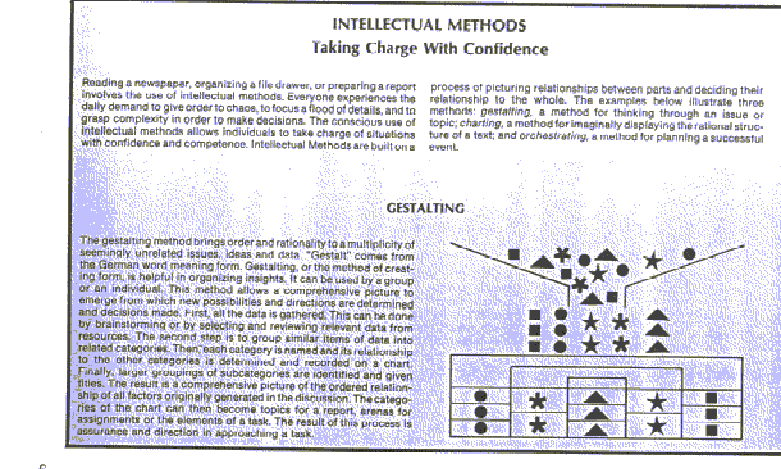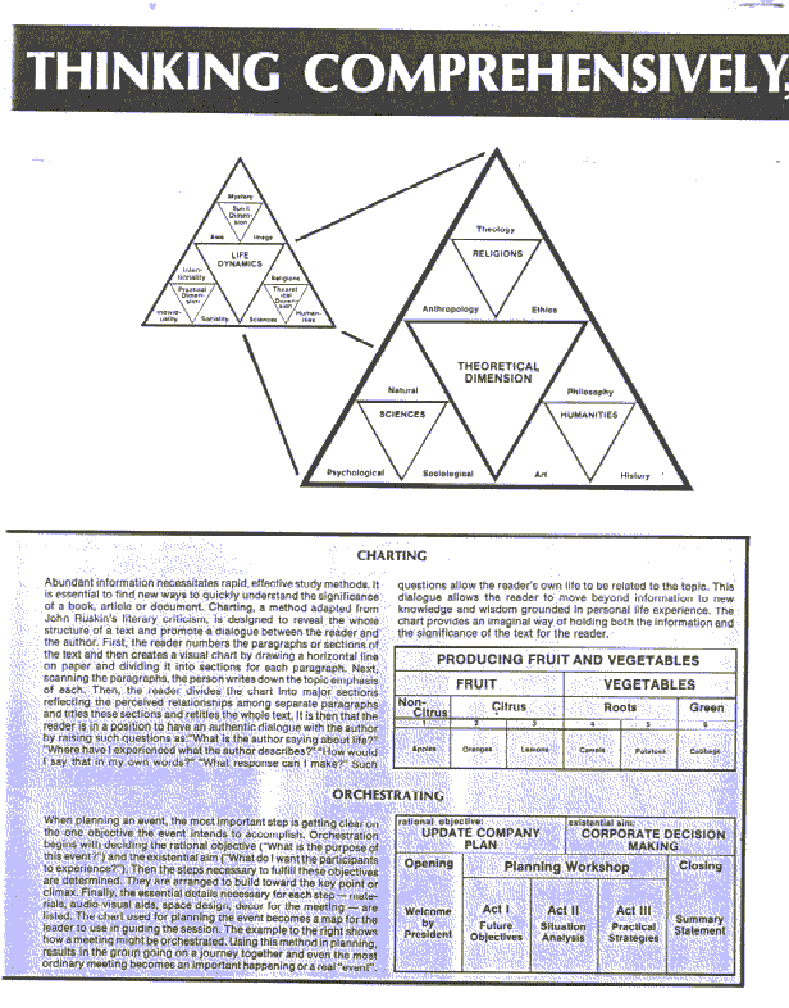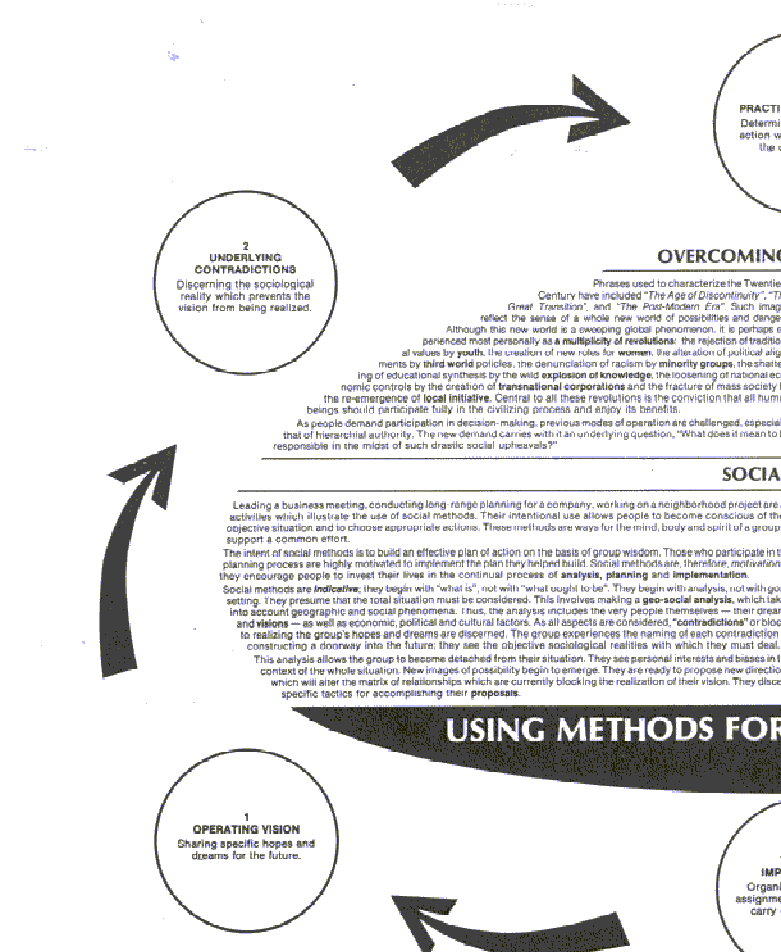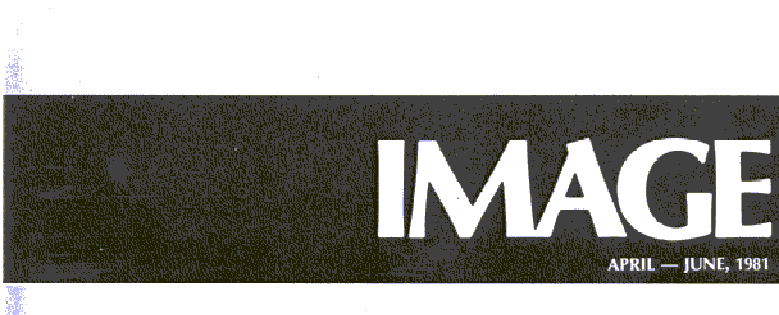

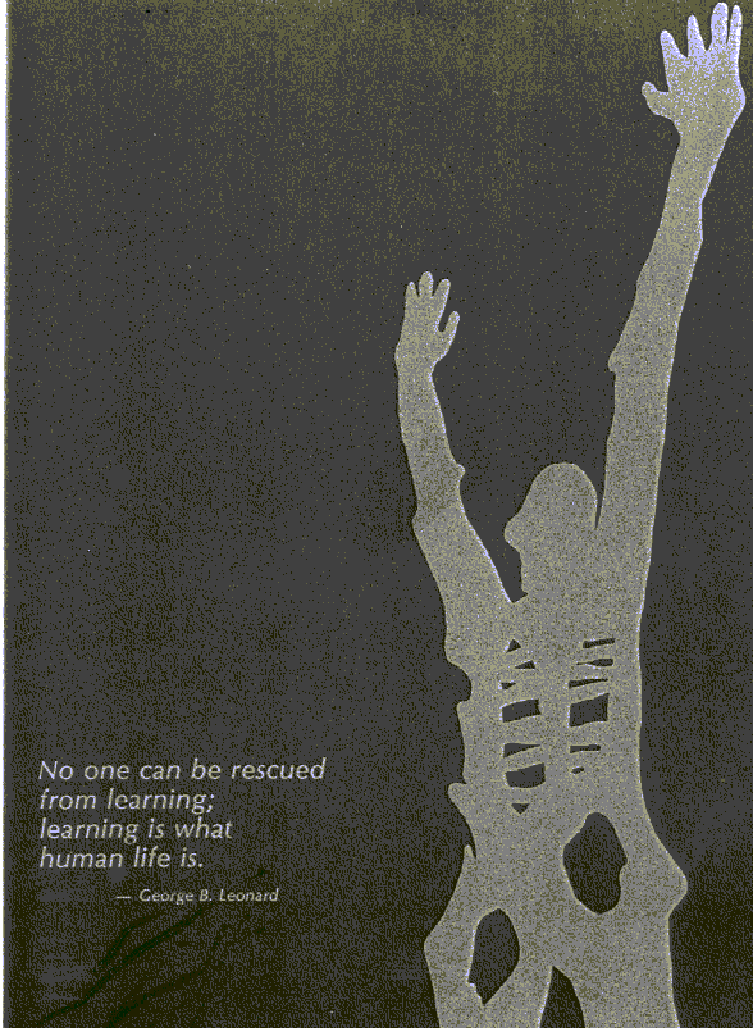
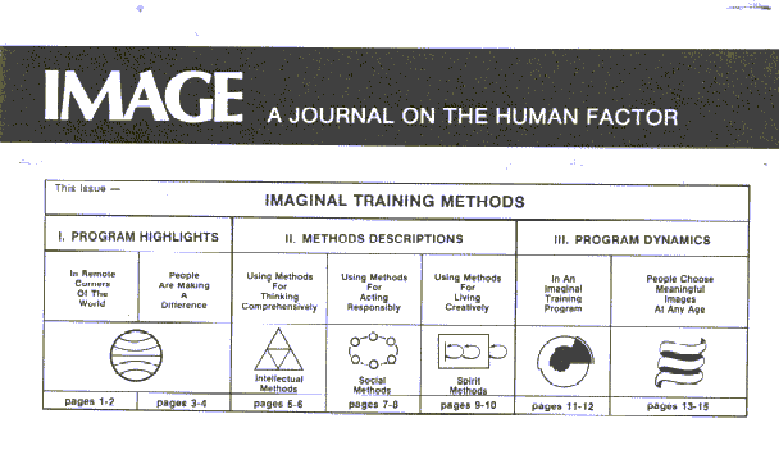
IMAGINAL TRAINING METHODS
This issue of IMAGE describes a unique approach to the challenge of effective training experienced alike by the private, public and voluntary sectors of society. Basic principles of this approach, called Imaginal Education, are presented in order to encourage others to apply these methods in a variety of training situations.
SECTION 1: PROGRAM HIGHLIGHTS
"Meeting the Training Challenge"
SECTION 11: METHODS DESCRIPTIONS
"Methods for Thinking, Acting and Living"
SECTION 111: PROGRAM DYNAMICS
"Training Programs With a Human Bias"
IMAGE
A Quarterly Publication
Vol. Xl No. 2
Prepared by
the Research Staff
of
THE ECUMENICAL INSTITUTE
and
THE INSTITUTE OF CULTURAL AFFAIRS
~-

!2 (.,~1

In the last 30 years, the research staff of the Institutes have developed methods and curricula for equipping people to live ettectively in this new age. This has resulted in the creation ot Imaginal Education, a unique approach to training.
Imaginal Educatlon has been used In primitive and technologically advanced situations,
with minimally and highly trained people, literate and i Illterate, ranging in age trom six months to 96 years. It has been used by persons with years of teaching experience and those with none.
The aims of Imaginal Education are to: 1) provide tools for critical reflection; 2) develop means for respon
sible participation In society and 3) elicit the courage required for creative living. This process begins with the awakening of consciousness by challenging old Images and providing new ones.
MEETING METHODS FOR THINKING, PROGRAMS
THE TRAINING CHALLENGE ACTING AND LIVING WITH A HUMAN BIAS
Section I Section 11 Section 111
As nations today seek to bring voca Global society today depends on a I n the last few decades the world has
tional skills, and social participation technology that has produced both experienced the birth of a new civili
to the most remote community, they mindstretching images of possibility zation as pervasive and discontinu
faceacomplextask. Fourbillionpeo and agonizing crises and despair. ous as the shift from prehistoric to
ple are moving into a future which is The continuing growth of technology agricultural civilization. This new
shifting more rapidly than past gener and increasing specialization have postindustrial civilization, precipi
ations imagined possible. Educa brought major changes in business tatedbymoderntechnology,secular
tional systems in every part of the and education. Deep alterations have ization and urbanization, is breaking
world are woefully inadequate to the reshaped the traditional institution of up longcherished economic, politi
task. Affluent and povertystricken the family. The demand for grass cal and cultural institutions. This
nations alike are in aquandry. If uni roots participation has intensi transformation is revolutionizing
versal education has become neces fied.There is a growing fear that this human values and shaping new
sary, how is it made accessible? What technological culture lacks an ethical trends in "social character." Human
structures and designs will equip base for decisionmaking. What does beings grow up sooner, are more
ordinary people to participate in it mean to be equipped with voca adaptive, and experience demands
shaping their own and the planet's tional skills for living in a complex for greater individuality. They search
future? and changing world? How can all lev beyond motive for meaning, crave
Over the past 30 years, the Institutes els of society be incorporated in wholeness and balance in life, and
have initiated a number of exper responsible decisionmaking? understand themselves in far more
iments attempting to answer these Becauseofthecontinuingexpansion complex terms than any previous
questions: of information, training programs people.
. programs designed to address need to emphasize methods, rather Amajorobjectiveofimaginaltraining
pressing social concerns using a than content. The scientific method programs is for participants to
minimum of professional mate itself is more useful than the tem assume responsibility for their own
rials and trained experts. porary results of any specific exper images, for society and for the future.
· shortterm courses of intensive iments; the capacity to understand Staffs of imaginal training programs
study which allow employed peo and participate in social change is encourage a change from depend
ple to receive needed training more important than knowledge of ence on external forces to interior
while continuing to work, particular sociological theories. resolves. They work with people's
. ~ ~ ~ . People need personal life methods basic operating images rather than
. compact currlcula wnlcn empna ~
size methods for selfreliance, enabling integrity, objectivity and with ideas or information which may
selfsufficiency and self responsibi!ity rather than philos be only tangentially related to these
confidence. ophies or Ideologles. images.
The last section of IMAGE describes
Section I of this issue highlights nine Section II describes Methods For the dynamics of an imaginal training
ot these experiments, their purpose, Thinking Comprehensively (Intellec program. The section begins with
general descriptlon~ and selected tual Methods), Methods For Acting one example-Training, Inc.-which
results. Any oneoftheseexperiments Responsibly (Social Methods), and illustrates how the intellectual, social
is in itself minute in the long sweep of Methods For Llving Creatively (Spirit and spirit methods can be woven into
history, but all together they do Methods). Each of these methods an integrated participantcentered
represent fulfillment of the presump which are included in Imaginal program. This is followed by discus
tion: IT CAN BE DONE. THIS Education is introduced by a brief sion and illustrations of three basic
HUMAN NEED CAN BE MET. To statement on its social origins, assumptions of Imaginal Education:
gether the programs dramatize that explained through an accompanying 1) people operate out of images, 2)
"in remote corners of the world, image, and illustrated with sample life isa journey, and 3) anything can
people are making a difference." applications. be taught to anyone.
2
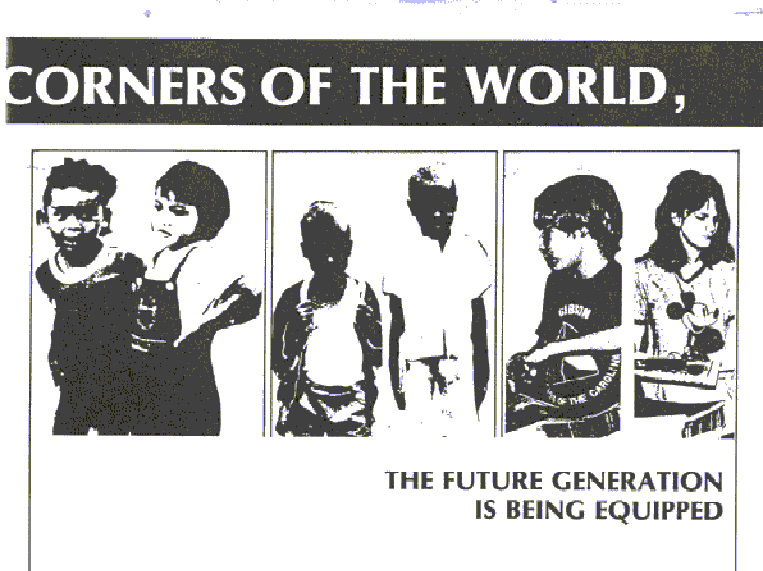
MALNUTRITION CUT BY 60% Mactan: Philippines
· In the Philippines, children from birth to four years of age are most severely affected by malnutrition, suffering physical disabilities, mental retardation and even death.
· In 1976 a fullday Early Learning Center was established in Sudtonggan to provide nutrition education for parents and a meal, two snacks and curriculum for their children.
· In four years childhood malnutrition was reduced by 60% and the infant mortality rate by twothirds.
· I n 1979 9 raduates of a sevenweek school in Sudtonggan set up Early Learning Centers for nutrition in 24 other villages on Mactan Island.
· By 1980, 5000 children were in the centers. Supplementary programs for their families had begun in home gardening, basic nutrition and preventive health care.
NONPROFESSIONALS IN MASS EDUCATION Nairobi: Kenya
In 1975 only half of 8000 youth under 14 years old were in school in Kawangware on the outskirts of Nairobi.
In 1976, 35 volunteer teachers from the village organized and taught classes in literacy and general education.
· Thecomprehensivecurriculumincludes English, Swahili, mathematics, history, current events and handicrafts.
| · Ranging in age from five to fourteen years, 5000 children have participated in supplementary and alternative primary school programs.
· By the end of the first year, 800 of these children qualified and registered at an appropriate school level; the number passing exams for secondary school jumped from one to seventeen.
.
.
TRANSITION TO RESPONSIBLE ADULTS Chicago: USA
· Twenty percent of high school graduates in the USAarefunctionally illiterate. The unemployment rate for teenagers is over 20%.
In 1973 a residential supplementary education program, The Student House, was set up in Chicago for junior high school youth.
The character formation curriculum provides practical skills, intellectual methods, physical fitness and global travel.
.
In six months during 1979, 25 youth earned $10,000 through parttime employment to pay for their travel to developing nations for a year of voluntary service.
· Forty percent of the students in the 197980 school year received academic or citizenship awards from their schools and 100% had passing grades.

UNEMPLOYED GET AND KEEP JOBS Chicago: USA
The national rate of unemployment in the USA is 7.4%. It is double that among minority groups.
Training, Inc., a thirteenweek clerical training program for welfare recipients, was opened in 1975 by the Central YMCA Community College with the support of local business and government agencies.
The "learnbydoing" curriculum gives the trainees new images of competence through achievement.
· To date, 900 students, (about 97% of the entrants) have completed the program.
Ninety percent are placed in jobs; 85% retain their jobs for at least a year. One employer of eight graduates reports that all are still employed after two years and three have had significant promotions.
THE DISENGAGED ARE LEARNING SKILLS
FOR PARTICIPATION
![]()
BRIDGING
NORTHSOUTH GAP
24 Time Zones
Seventyfive percent of the world's population lives on onefifth of the world's resources.
Training of volunteer consultants started in 1974 in Europe and North America.
Between 1974 and 1978 over 800 volunteers traveled to developing nations to serve for up to five years in 24 Human Development Projects, one in each zone.
Volunteers contributed their travel and experience in education, business and industry, health and social services and agriculture.
During the last two years, in the village of Conacaste de San Miguel, Guatemala, DePauw University students and lowa families helped to provide the materials and expertise to install a water and irrigation system.
.
WOMEN LEAD
IN DEVELOPMENT
Beni Suef: Egypt
Women in Egyptian villages have been confined to their homes for centuries by tradition and religious taboo.
.
In 1976 the village authorities gave permission for the women to participate in a village development consu Itation.
During the consultation the village residents saw the role they could play in changing the story of hopelessness into one of possibility for the future.
Bayad women assumed responsibility for community development in the preschool, health and education guilds, and the marmalade factory.
In 1980, following a meeting led by Bayad women, the women of El Alalma spearheaded a fundraising drive to ensure a fresh water system for their village.
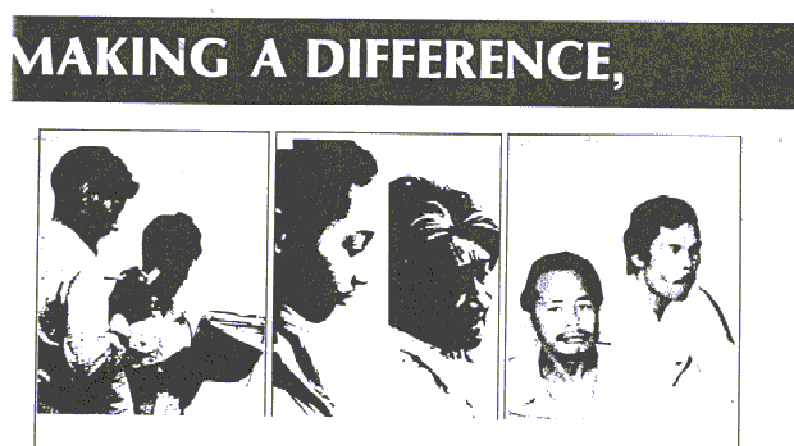
LOCAL COMMUNITIES ARE BEING TRAINED
IN SELFDEVELOPMENT
SERVICE CORPS FOR INDIAN VILLAGES Maharashtra: India
· In India 342 million people live in rural villages, of these 75% are underemployed in agriculture.
In 1976, The Human Development Training School was established in Maliwada to train Indian youth in village development.
The curriculum of the HDTS includes modules in Economic, Social and Human Development alternating formal classroom and practical field experience.
More than 2000 young people have received training in 18 schools and 1700 have worked in the villages of Maharashtra for one to fouryears.
These volunteers have been involved in 232 village projects. Three of these became demonstrations for blocks of 100 villages and are now regional training centers.
LOCAL COMMUNITIES DETERMINE FUTURE In Every County: USA
· Local community residents sense that they are cut off from the decisions that affect their lives.
In 1974, a oneday Town Meeting was designed to engage residents in discerning community hopes, challenges, and proposals for the future.
During the Bicentennial 5000 Town Meetings were held in the USA. In M ississippi, '03 took place from 19781979.
Across the nation, the program was supported by the public and private sectors; for example, the Governor's Office of Human Resources, Xerox and South Central Bell in Mississippi.
In Mississippi, 701 community proposals were implemented ranging from cleanup days to building new schools, from incorporation as a city to cooperation across county lines.
STRUCTURAL REVITALIZATION North Sumatra: Indonesia
· To ease the pressure of 63% of the Indonesian population living on the island of Java, the government has begun to emphasize rural development.
In conjunction with these plans, in 1978 a Human Development Project was begun in the remote fishing village of Bubun, North Sumatra.
Local residents, government and company representatives and international consultants participated in the weeklong launching consultation.
One year later a threeweek training school in Bubun equipped representatives of six other village growth centers to launch similar projects.
Planning seminars for private corporations and government agencies are helping catalyze delivery of supportive services to these
CREATING HOLISTIC MODELS
![]()
Since the beginning of the Twentieth Century, science has played a leading role in shaping society. The advent of one discovery after another quickly shifted images of pioneering from opening up new lands to opening up new areas of science. The breakloose of science which produced this technological revolution unprecedented in scope and innovation has now pushed society beyond the industrial form which birthed it. Although significant scientific discoveries have continued since men landed on the moon and the earth was viewed from space, the human perspective has changed forever. The 1980s is a time of transition to a postindustrial society in which the frontier has shifted to humanness itself, to the consciousness that creates science.
In this transition period, the residue from the scientific and economic dominance of the first half of the century has itself become a problem. "Welltrained" persons emerge from our educational institutions highly specialized, but without a way to understand and relate to the complex interrelationships of an interdependent world. Narrowly focused occupational training is inadequate. Individuals find themselves struggling with how to assimilate, organize, reflect upon and decide about quantities of data which daily assault them.
Operating with absolute laws and patterns will no long'er work in this new understanding of a dynamic world and everexpanding knowledge. Instead, temporal (transitory)
models are needed that still hold all our wisdom and serve as guidelines until it is necessary to change them. One such temporal, comprehensive model is the Life Triangles.
The Life Triangles is an attempt to include all of the life dynamics in one simple design. The theoretical dimension of these triangles is meant to encompass all areas of civilization's accumulated wisdom. The sciences and humanities are shown as complementary rather than in dichotomy. This complementary relationship is reflected in scientists who exhibit artistic sensitivity and artists who master complex technique. Further, the model presents the theoretics of religion as complementary to both the sciences and humanities. This is to indicate that in addition to knowledge of the physical world and of human creativity, there is ontology-a branch of knowledge that investigates the nature, essential properties and relations of being.
The Life Triangies represent one attempt to think comprehensively. They are the product of some of the intellectual methods which follow and are a tool for planning curriculum. They can be used to test the degree to which any course of study reflects the totality of life's experience. The social process triangles which were presented in the last issue of IMAGE are also a temporal model; they are meant to hold all available knowledge in relation to the dynamics of society.
